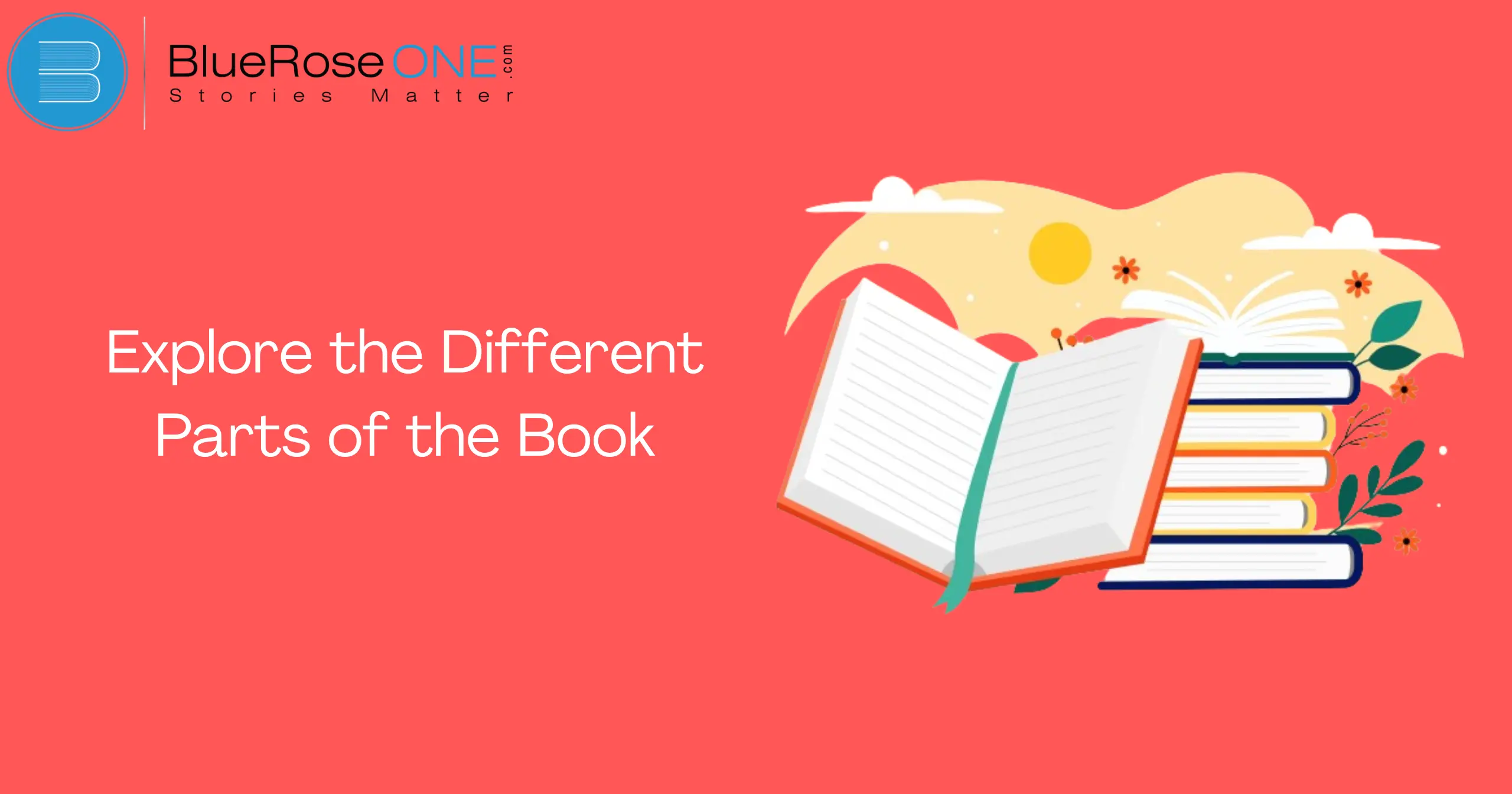Books are more than just words on pages, they are carefully structured creations designed to engage, inform, and entertain readers. Understanding the different parts of the book can enhance your appreciation and use of these timeless tools. This guide will take you through each component of a book, detailing its purpose and significance.
The Cover
Front Cover
The front cover is a crucial part of the book as it creates the first impression and draws readers in. It typically includes the book title, author’s name, and eye-catching artwork or imagery.
The front cover is designed to attract attention and give a hint of the book’s content and genre. A well-designed front cover is essential for standing out on the shelves and enticing readers to pick up the book, making it a vital component of the parts of the book.
You may also read: 10 Best Books on Writing Every Aspiring Author Should Read
Title and Author
Two of the book’s most important elements are the author and title on the cover. While the author’s name may draw readers who are already familiar with their work, the book’s title offers readers an overview of its contents.
When combined, they provide an initial impression that persuades prospective readers to pick up the book. To ensure that the book stands out on the shelf and is effectively marketed, these components must be shown in a clear and conspicuous manner.
Subtitle and Design
The subtitle and design are crucial parts of the book’s cover. The subtitle provides additional information about the book’s content, making it easier for readers to understand what to expect.
Meanwhile, the design, including typography and imagery, attracts potential readers’ attention and conveys the book’s tone and genre. Together, these elements enhance the book’s appeal and help it stand out on the shelves.
You may also like: What is Imprint in publishing? A Comprehensive Guide
You may also like: Tone Examples in Literature: 15 Must-Know Types With Examples
Back Cover
The back cover is one of the essential parts of the book. It typically includes a brief summary or blurb, an author bio, and sometimes quotes or reviews.
This section gives potential readers a glimpse of the book’s content and the author’s background, helping them decide whether to purchase or read it. In essence, the back cover plays a crucial role in marketing and can greatly influence a book’s success.
Blurb or Summary
One of the most important parts of the book that draws in potential readers is the synopsis or blurb on the back cover. It gives a brief synopsis of the book’s themes, plot, and key characters without giving too much away.
This synopsis is meant to pique readers’ curiosity and serve as a bridge between the different sections of the book. A well-written synopsis makes it easy for readers to comprehend the subject matter and recommendation of a book.
Author Bio and Reviews
The “Author Bio and Reviews” section on the back cover is a crucial part of the book. It usually includes a brief biography of the author, highlighting their qualifications and other works, which helps establish their credibility.
Reviews or endorsements from other authors, critics, or publications can also be featured here to attract potential readers by showcasing positive feedback.
This section is vital for giving readers a sense of the author’s background and the book’s reception, helping them decide whether to make a purchase.
You may also read: Top 10 Ebook Platforms for Self-Publishing Authors.
You may also like: 20 Satire Examples in Real-World Every Writer Should Know
The Spine
Title and Author on the Spine
A book’s spine is important for both its appearance and use. When a book is shelved, it usually shows the title and author’s name, making identification simple.
The author’s name is typically smaller but still apparent, and the title is typically the most noticeable component. Readers can rapidly find and choose books using this arrangement.
Comprehending these components is essential to realizing how the many elements of the book come together to create an aesthetically pleasing and approachable whole.
Publisher’s Logo
An essential component of the book’s spine is the publisher’s emblem. This tiny but important design feature, which is near the bottom, stands in for the publishing business that created the book.
It helps with brand recognition in addition to giving the impression of professionalism. The publisher’s emblem on the spine serves as a crucial distinguishing feature for readers and collectors, drawing attention to the distinct sections of the book that enhance its overall appeal.
You may also like: How to Avoid Plagiarism in Assignments: 10 Easy Steps
You may also read: Top 10 Arundhati Roy Books You Must Read in 2025
Font Matter
The front matter includes several preliminary pages that provide essential information about the book.
Title Page
A vital component of the book that is present from the outset is the title page. It contains the title of the book, the author’s name, the publisher’s name, and any subtitles.
This page serves as an introduction to the book and aids in its identification. When delving into the various sections of the book, it is imperative to comprehend the significance of the title page, since it establishes the reader’s context and offers crucial publication information.
Copyright Page
A vital component of the book’s front matter, the copyright page is usually seen immediately following the title page. It contains crucial legal details such as the name of the copyright holder, the publication year, and a copyright notice.
The ISBN (International Standard Book Number) and disclaimers are frequently included on this page as well. Knowing this section of the book gives readers information about the book’s release and helps to protect the rights of the writers.
Dedication and Acknowledgments
The “Dedication” and “Acknowledgements” parts of a book’s Front Matter are crucial for acknowledging contributions and special touches.
While the Acknowledgements part expresses gratitude to those who assisted in the creation of the book, such as editors, researchers, or family,
the Dedication section is where authors pay tribute to a specific person, frequently a mentor or loved one. Both of these passages are crucial to the book since they shed light on the author’s thankfulness and the teamwork that went into the writing.
Table of Contents
The “Table of Contents” is a crucial element found in the front matter of a book, which is one of the essential parts of the book. It provides readers with an organized list of the book’s chapters or sections, making it easier to navigate the content.
This section is typically located early in the book and helps readers quickly find specific topics or chapters they are interested in, enhancing their overall reading experience.
You may also like: The Rise of Shakti by Megha Dinesh: Book Review
You may also read: Left Behind Series Books in Order: Where to Begin
Foreword and Preface
The foreword and preface are essential sections of a book’s front matter that set the reader’s expectations. The context and relevance of the book are introduced in the foreword, which was written by a person other than the author. It frequently gives a background on the author or a personal recommendation.
In contrast, the author writes the introduction, which outlines the goals of the book, its creation, and what readers might anticipate. Comprehending these components aids readers in understanding the structure and background of the book.
Introduction
The “Introduction” is a crucial part of the book’s front matter, providing readers with an overview of what to expect. It sets the stage, explaining the book’s purpose, scope, and structure.
This section helps readers understand the author’s intent and the book’s context. By reading the introduction, readers get a preview of the key themes and ideas that will be explored in the following chapters, making it an essential element in understanding the different parts of the book.
You may also read: How to Get a Book Deal in 2024: 6 Easy Steps to Success
Body Matter
The body matter is the core of the book, containing the main content.
Chapters
The main divisions found in a book’s body are called chapters. They facilitate content organization, which helps readers follow the material or story more easily.
Every chapter usually concentrates on a certain aspect of the story or subject matter, offering readers a welcome break. The book’s readability and flow are improved by distinct chapter names and a unified structure, which makes it easier for readers to move between the various sections.
Chapter Titles
A vital component of the book’s content, chapter titles act as essential directional cues for readers. They aid in dividing the story into digestible chunks and offer a preview of each section’s material.
Good chapter titles set the tone and allude to the subject that follows in a way that is both descriptive and captivating. Chapter titles improve the overall reading experience and make it simpler for readers to follow the plot by directing them through the book’s structure.
Subheading
Subheadings are an essential component of the book’s body material since they aid in the division of dense information into digestible chunks.
They aid in text navigation by guiding readers through various themes or topics. Good subheadings improve readability and organization by giving a concise summary of the topics covered in each section.
Subheadings help authors make sure that important information is easy for readers to identify and comprehend, which improves the readability and accessibility of the material overall.
You may also read: Pulitzer Prize Fiction Winners by Year: A Complete List
Sections and Subsections
Within the primary heading “Body Matter,” subsections and sections are essential for structuring a book’s content. The book is divided into sections that each focus on a different facet of the subject. Subheadings within these sections help readers follow along by further breaking the material down into digestible portions.
This arrangement facilitates the clear presentation of complicated ideas and improves readability. Comprehending these sections of the book guarantees that the information is rationally organized and easily accessed.
Illustrations and Tables
“Illustrations and Tables” are essential components of a book’s content that improve reader comprehension and engagement. Images that depict concepts visually, like drawings or photos, help people understand difficult concepts more easily.
Contrarily, tables arrange data in a clear, succinct manner that makes it easy for readers to compare and understand the data. These components are essential to the book since they enhance the material and provide structure to the overall story.
Footnotes and Endnotes
Footnotes and endnotes are essential parts of the book that provide additional information or citations without cluttering the main text. Footnotes appear at the bottom of the page where the reference is made, while endnotes are gathered at the end of the chapter or book.
Both serve to clarify or expand on details mentioned in the body matter, helping readers understand sources or context better. They are crucial for academic and non-fiction works, enhancing the book’s credibility and readability
You may also read: What is Byline and How Does It Impact Author Credibility?
Back Matter
The back matter includes supplementary material that supports the main text.
Appendix
An “Appendix” is a section of a book’s “Back Matter” that contains supplementary material that complements the main plot but isn’t essential to the narrative.
It’s frequently used for in-depth information, graphs, or references that improve comprehension for the reader. An appendix allows writers to provide thorough information while maintaining the clarity of the primary narrative.
This section keeps the main material focused and interesting, which makes it a crucial component of the book, especially in non-fiction works.
Glossary
A glossary is an essential part of the back matter in many books. It provides definitions for specialized or difficult terms used throughout the text, helping readers understand complex concepts.
Located at the end of the book, this section clarifies jargon or technical language, ensuring that readers grasp the material more effectively.
By including a glossary, authors enhance reader comprehension and make their work more accessible, especially in books with unique terminology or intricate subject matter.
Bibliography
An important component of the book that is located in the back matter is the bibliography. It includes a list of all the references and sources the author used to write the book.
This section aids readers in locating the source documents and confirming the data presented. writers can add credibility to their work and give credit to the original writers by incorporating a bibliography. It’s a crucial element of the book’s sections, particularly in academic and research-focused writings.
Index
An essential component of a book’s back matter, the index provides a thorough overview of the contents. To make finding specific material easier for readers, it includes a list of important terms, subjects, or names referenced throughout the book together with their corresponding page numbers.
For example, an index makes it easier for readers to find key ideas or references in textbooks or non-fiction publications. Comprehending this section of the book improves its accessibility and usefulness, making it easier for readers to browse its contents.
Author Bio
An “Author Bio” is a detailed section often found in the back matter of a book. Unlike a brief author bio, this extended version provides readers with an in-depth look at the author’s background, achievements, and other relevant experiences.
This part of the book helps build credibility and establish a connection with readers, offering insight into the author’s qualifications and personal journey. Including a well-crafted author bio enhances the overall understanding of the book and its creator.
You may also like: Audible Titles vs. Physical Books: Which One is Better for you?
Special Features
Special features add extra value to the book and can include various elements.
Maps and Diagrams
The book’s maps and graphics, which improve comprehension and engagement, are crucial components. Maps give readers a visual picture of the location of a story, which makes it simpler for them to follow the geographical parts of the plot.
On the other hand, diagrams help break down information into manageable chunks by illuminating difficult concepts or processes.
By providing a clear, visual context for the text, these characteristics can greatly enhance the reader’s comprehension and enjoyment of the book.
Photographs
Photographs can significantly enhance the parts of the book, especially in non-fiction and educational texts. They provide visual context and help readers grasp complex ideas more easily.
Including photographs in a book can make information more engaging and memorable. Whether used in the introduction, as chapter headings, or in the appendices, photographs serve to complement the written content and offer a richer reading experience. Properly integrated, they are a vital part of the book’s layout and design.
Bonus Content
Books with bonus content frequently contain extra material that enhances the reading experience. Anything from author notes to deleted scenes to unique artwork and behind-the-scenes looks at the writing process can be included here.
Bonus content enhances the worth and complexity of the main text and is usually found in the appendices or as additional parts.
Comprehending these sections of the book enables readers to recognise the additional work that writers do to provide a more comprehensive and captivating experience.
You may also read: 6 Professional Book Layout Design Tips
Digital Book Consideration
Digital books have unique features that enhance the reading experience.
Interactive Elements
Interactive components in digital books improve reader experience and engagement. Interactive tests, video contained within, and clickable links are a few examples of these components.
Writers can add more dynamism and engagement to their writings by incorporating these elements. A digital book could, for instance, have videos that enhance the text or interactive chapter links that make it simple for readers to travel between the various sections of the book. These kinds of elements can turn reading from a passive activity into an engaging journey.
Hyperlinks
In digital books, hyperlinks are clickable links that direct readers to additional content or related sections within the book or on external websites.
These links enhance the reader’s experience by providing instant access to references, further explanations, or multimedia elements, effectively connecting different parts of the book.
Hyperlinks are crucial for interactive e-books as they facilitate easier navigation and deeper engagement with the content, making them an essential component of modern digital reading.
Conclusion
Understanding the different parts of a book is essential for both readers and writers. Each component, from the cover to the back matter, plays a specific role in creating a cohesive and engaging reading experience. By appreciating these elements, you can enhance your reading enjoyment and improve your writing skills if you’re an aspiring author.
















